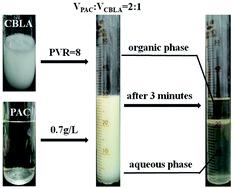当前位置:
X-MOL 学术
›
Environ. Sci.: Processes Impacts
›
论文详情
Our official English website, www.x-mol.net, welcomes your
feedback! (Note: you will need to create a separate account there.)
Colloidal biliquid aphron demulsification using polyaluminum chloride and density modification of DNAPLs: optimal conditions and common ion effect.
Environmental Science: Processes & Impacts ( IF 4.3 ) Pub Date : 2020-08-10 , DOI: 10.1039/d0em00248h Xue Liang 1 , Jun Dong 1 , Gaoliang Wei 1 , Nnanake-Abasi Offiong 1 , Chaoge Yang 1
Environmental Science: Processes & Impacts ( IF 4.3 ) Pub Date : 2020-08-10 , DOI: 10.1039/d0em00248h Xue Liang 1 , Jun Dong 1 , Gaoliang Wei 1 , Nnanake-Abasi Offiong 1 , Chaoge Yang 1
Affiliation

|
Dense non-aqueous phase liquids (DNAPLs) entrapped and pooled in aquifers serve as a long term source of groundwater contamination because of their low solubility and high density. Density modification displacement (DMD) with colloidal biliquid aphrons (CBLAs) is a promising approach to prevent DNAPL downward migration during surfactant-based remediation processes. CBLA demulsification and quick release of internal light organic matter is the key to density modification of DNAPLs. In this work, it is reported for the first time that polyaluminum chloride (PAC) could destabilize CBLAs efficiently. The optimum conditions for demulsification of CBLAs by PAC were obtained; the effects of several specific ions in groundwater on demulsification of CBLAs by PAC were investigated. The results indicated that the CBLA was completely demulsified by PAC within 10 minutes and released light organic matter. It recorded the highest demulsification efficiency when the addition ratio (VPAC/VCBLA) was 2 : 1, concentration of PAC was 0.7 g L−1 and the PVR of CBLAs was 8. Most cations (sodium, magnesium and calcium ions) had inhibitory effects on demulsification of CBLAs by PAC with increasing ion concentration, but iron ions had no effect on it. Sulfate anions showed a stronger inhibitory effect on demulsification of CBLAs by PAC compared to chloride ions. With PAC as the demulsifier, CBLAs could be demulsified efficiently, irreversibly modifying the density of trichloroethylene in 5 minutes.
中文翻译:

使用聚氯化铝和DNAPLs的密度修饰的胶态双液性Aphron破乳:最佳条件和常见离子效应。
夹带并聚集在含水层中的稠密非水相液体(DNAPLs)由于其低溶解度和高密度而成为长期的地下水污染源。胶体双液Aphrons(CBLA)的密度修饰置换(DMD)是一种在基于表面活性剂的修复过程中防止DNAPL向下迁移的有前途的方法。CBLA的破乳和内部轻质有机物的快速释放是DNAPLs密度修饰的关键。在这项工作中,首次报道了聚氯化铝(PAC)可以有效地破坏CBLAs的稳定性。获得了PAC对CBLAs进行乳化的最佳条件。研究了地下水中几种特定离子对PAC破乳CBLA的影响。结果表明,CBLA在10分钟内被PAC完全破乳,并释放出轻质有机物。当添加比例(V PAC / V CBLA)为2:1,PAC的浓度为0.7 g L -1,CBLA的PVR为8。大多数阳离子(钠,镁和钙离子)对PAC随着离子的增加对CBLA的破乳作用具有抑制作用。浓度,但铁离子对此没有影响。与氯化物离子相比,硫酸根阴离子对PAC破坏CBLA的破乳作用更强。使用PAC作为破乳剂,可以有效地破乳CBLA,在5分钟内不可逆转地改变三氯乙烯的密度。
更新日期:2020-09-23
中文翻译:

使用聚氯化铝和DNAPLs的密度修饰的胶态双液性Aphron破乳:最佳条件和常见离子效应。
夹带并聚集在含水层中的稠密非水相液体(DNAPLs)由于其低溶解度和高密度而成为长期的地下水污染源。胶体双液Aphrons(CBLA)的密度修饰置换(DMD)是一种在基于表面活性剂的修复过程中防止DNAPL向下迁移的有前途的方法。CBLA的破乳和内部轻质有机物的快速释放是DNAPLs密度修饰的关键。在这项工作中,首次报道了聚氯化铝(PAC)可以有效地破坏CBLAs的稳定性。获得了PAC对CBLAs进行乳化的最佳条件。研究了地下水中几种特定离子对PAC破乳CBLA的影响。结果表明,CBLA在10分钟内被PAC完全破乳,并释放出轻质有机物。当添加比例(V PAC / V CBLA)为2:1,PAC的浓度为0.7 g L -1,CBLA的PVR为8。大多数阳离子(钠,镁和钙离子)对PAC随着离子的增加对CBLA的破乳作用具有抑制作用。浓度,但铁离子对此没有影响。与氯化物离子相比,硫酸根阴离子对PAC破坏CBLA的破乳作用更强。使用PAC作为破乳剂,可以有效地破乳CBLA,在5分钟内不可逆转地改变三氯乙烯的密度。











































 京公网安备 11010802027423号
京公网安备 11010802027423号